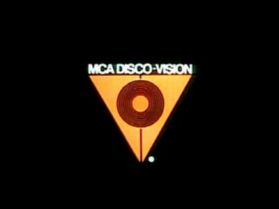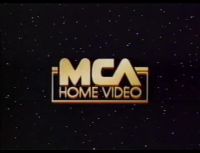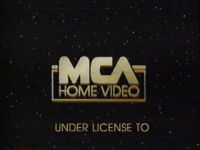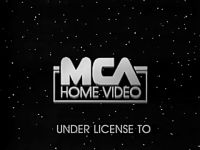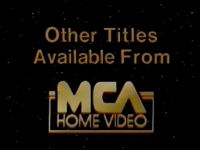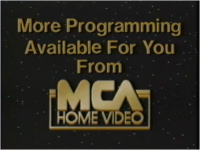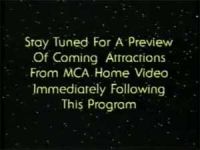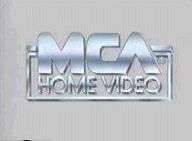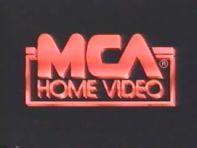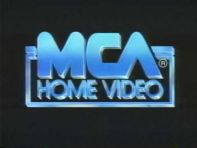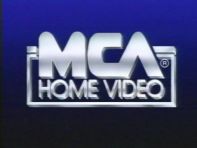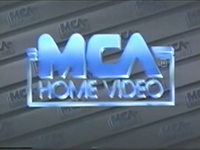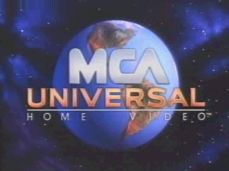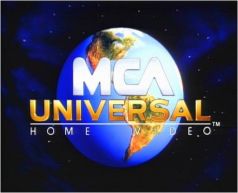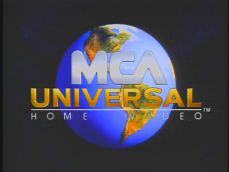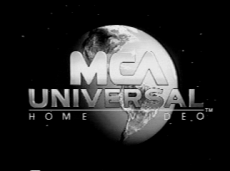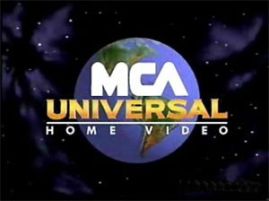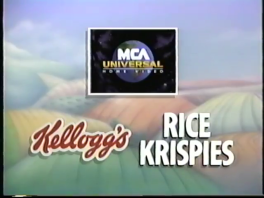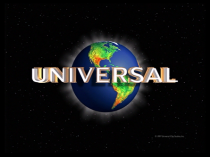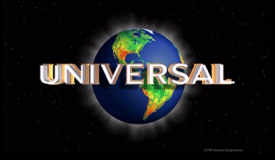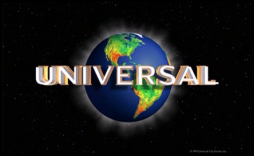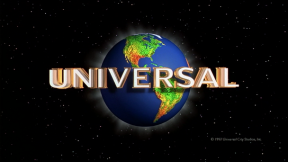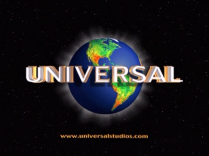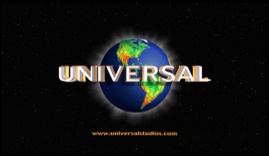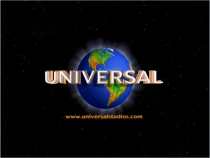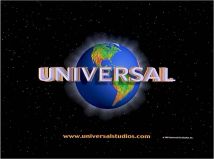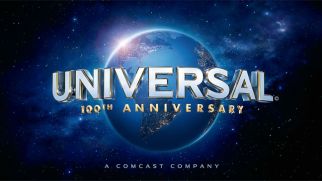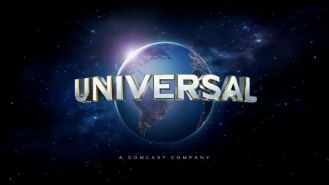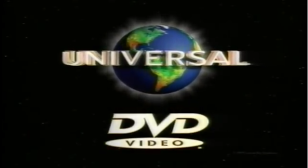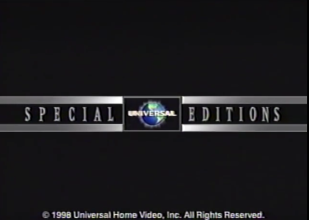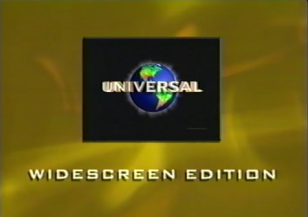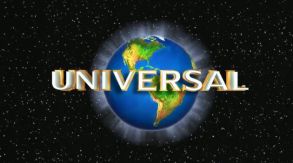Universal Pictures Home Entertainment
Jump to navigation
Jump to search
Logo descriptions by James Stanley Barr, Kris Starring, Matt Gauer, and indycar
Logo captures by V of Doom, EnormousRat, Dean Stewart Rumsey, Logoboy95, Mr.Logo,socoollogos and indycar
Editions by V of Doom, kidinbed, betamaxtheflyer, MariluHennerArtist45, Lizz Tetlow, Muzzarino, Nathan B. indycar, KirbyGuy2001 (Logoblin), UniversalFlorida1990, and FrozenHater.
Video captures courtesy of Tlogos, LogoLibraryinc, titigag89, fredbur50, Watcher3223, EnormousRat and Evelyn Ain
Background: Universal Studios' home entertainment unit descended from MCA's "DiscoVision" system, which was created to develop the laserdisc system and entered the market in 1978 after development that started in the late 1960's, and the first demonstration of the system in 1972. DiscoVision was riddled with issues, and numerous films were released from Universal, with Disney, Warner Bros., and Paramount also licensing titles to the label. With DiscoVision failing, MCA entered the home videocassette market in late 1980, creating "MCA Videocassette" to market releases to VHS and Betamax. DiscoVision was finally folded as a software label by MCA in 1981 reorganizing the division as "MCA Videodisc", and also expanded their videodisc operations to cover RCA's "SelectaVision" videodisc format. However, the "MCA Home Video" moniker was applied to both VHS and disc releases and became simply known as "MCA Home Video", alternating with the "MCA Videocassette" name until 1984. In 1990, MCA Home Video renamed itself as "MCA/Universal Home Video" to capitalize the Universal Studios name and to coincide with Universal's 75th Anniversary, alternating with the "MCA Home Video" name in 1992 or 1995. In December 1996, it renamed itself as "Universal Studios Home Video" when MCA was reincorporated as Universal Studios and in 2005 changed once again into "Universal Studios Home Entertainment". In 2015, the home entertainment division was restructured and was renamed as "Universal Pictures Home Entertainment". In January 2020, it was announced that Universal and Warner Bros. Home Entertainment would be partnering to form a 10-year joint venture, which will see new and library titles from both companies being released on 4K UHD, Blu-ray and DVD under one entity; the venture is expected to launch in early 2021, pending regulatory approval.
MCA DiscoVision
1st Logo
(1977)
Nickname: "Glowing V-LaserDisc"
Logo: We start out with glowing blue light in the center of a black background. The glowing light shrinks until it is the size of a small yellow circle embedded in an orange upside down triangle split vertically in the center. The words "MCA DISCO-VISION" appear on top of the triangle, and while the circle turns as orange as the triangle, the copyright symbol appears on the bottom right area.
FX/SFX: The shrinking of the light in the center of the screen.
Music/Sounds: An 8-note percussive string tune followed by a dramatic orchestral finish.
Availability: This was only used in a 1977 test pressing that was used as a public display by MCA. It can, however, be seen <a href="https://web.archive.org/web/20170721175952/http://blamld.com/DiscoVision/Multimedia.htm" target="_self">here</a>.
Editor's Note: Because this was only used on a test pressing, this logo was a surprise find.
2nd Logo
(1978-1981)
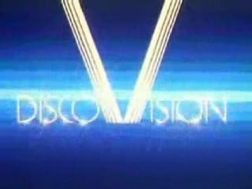
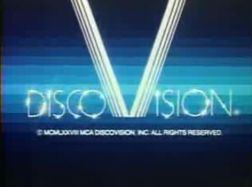
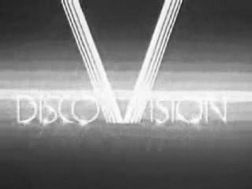
<iframe frameborder="0" height="167" src="http://wikifoundrytools.com/wiki/closinglogos/widget/genericvideo/33dff6732e5940ff0f73292cd965e8c24661a062" width="297"></iframe>
<a class="external" href="http://wikifoundrytools.com/wiki/closinglogos/page/Universal+Studios+Home+Entertainment/widget/youtubevideo/797c1a794f8d00c6e015b0c3d4f619ec2ef290cd" rel="nofollow" target="_blank" title=", shockwave-flash@http://wikifoundrytools.com/wiki/closinglogos/page/Universal+Studios+Home+Entertainment/widget/youtubevideo/797c1a794f8d00c6e015b0c3d4f619ec2ef290cd">
Nickname: "Big V", "Majestic V"
Logo: On a black background, the words "DISCOVISION" crawl across the entire screen in a rainbow of colors like a kaleidoscope, and rows of vertical orange lines appear on the screen. The center lines open up in a rainbow of colors to reveal a white "V", with "DISCO" and "ISION" appearing on the left and right sides of the "V", respectively, appearing on a blackish background with a large Bondi blue streak in the middle. The DiscoVision logo sparkles for a second and then an abrupt cut to black.
Variants:
FX/SFX: The crawling of the "DISCOVISION" letters, the appearance, splitting and sparkling of the logo, all in Scanimation.
Music/Sounds: A flute tune accompanied by a lavishly orchestrated theme. On some releases, such as Bustin' Loose, it's silent.
Availability: Seen on every DiscoVision release from 1978 to 1981. To find them, look for packaging where the print logo is on a gray background with the space around the “V” pelling to both sides revealing the movie that is printed on the disc.
Editor's Note: A great logo. However, it is tough to find in good quality, as poor manufacturing practices have caused most DiscoVision discs to degrade over the years.
Editor's Note: None.
Logo captures by V of Doom, EnormousRat, Dean Stewart Rumsey, Logoboy95, Mr.Logo,socoollogos and indycar
Editions by V of Doom, kidinbed, betamaxtheflyer, MariluHennerArtist45, Lizz Tetlow, Muzzarino, Nathan B. indycar, KirbyGuy2001 (Logoblin), UniversalFlorida1990, and FrozenHater.
Video captures courtesy of Tlogos, LogoLibraryinc, titigag89, fredbur50, Watcher3223, EnormousRat and Evelyn Ain
Background: Universal Studios' home entertainment unit descended from MCA's "DiscoVision" system, which was created to develop the laserdisc system and entered the market in 1978 after development that started in the late 1960's, and the first demonstration of the system in 1972. DiscoVision was riddled with issues, and numerous films were released from Universal, with Disney, Warner Bros., and Paramount also licensing titles to the label. With DiscoVision failing, MCA entered the home videocassette market in late 1980, creating "MCA Videocassette" to market releases to VHS and Betamax. DiscoVision was finally folded as a software label by MCA in 1981 reorganizing the division as "MCA Videodisc", and also expanded their videodisc operations to cover RCA's "SelectaVision" videodisc format. However, the "MCA Home Video" moniker was applied to both VHS and disc releases and became simply known as "MCA Home Video", alternating with the "MCA Videocassette" name until 1984. In 1990, MCA Home Video renamed itself as "MCA/Universal Home Video" to capitalize the Universal Studios name and to coincide with Universal's 75th Anniversary, alternating with the "MCA Home Video" name in 1992 or 1995. In December 1996, it renamed itself as "Universal Studios Home Video" when MCA was reincorporated as Universal Studios and in 2005 changed once again into "Universal Studios Home Entertainment". In 2015, the home entertainment division was restructured and was renamed as "Universal Pictures Home Entertainment". In January 2020, it was announced that Universal and Warner Bros. Home Entertainment would be partnering to form a 10-year joint venture, which will see new and library titles from both companies being released on 4K UHD, Blu-ray and DVD under one entity; the venture is expected to launch in early 2021, pending regulatory approval.
MCA DiscoVision
1st Logo
(1977)
Logo: We start out with glowing blue light in the center of a black background. The glowing light shrinks until it is the size of a small yellow circle embedded in an orange upside down triangle split vertically in the center. The words "MCA DISCO-VISION" appear on top of the triangle, and while the circle turns as orange as the triangle, the copyright symbol appears on the bottom right area.
FX/SFX: The shrinking of the light in the center of the screen.
Music/Sounds: An 8-note percussive string tune followed by a dramatic orchestral finish.
Availability: This was only used in a 1977 test pressing that was used as a public display by MCA. It can, however, be seen <a href="https://web.archive.org/web/20170721175952/http://blamld.com/DiscoVision/Multimedia.htm" target="_self">here</a>.
Editor's Note: Because this was only used on a test pressing, this logo was a surprise find.
2nd Logo
(1978-1981)



<iframe frameborder="0" height="167" src="http://wikifoundrytools.com/wiki/closinglogos/widget/genericvideo/33dff6732e5940ff0f73292cd965e8c24661a062" width="297"></iframe>
<a class="external" href="http://wikifoundrytools.com/wiki/closinglogos/page/Universal+Studios+Home+Entertainment/widget/youtubevideo/797c1a794f8d00c6e015b0c3d4f619ec2ef290cd" rel="nofollow" target="_blank" title=", shockwave-flash@http://wikifoundrytools.com/wiki/closinglogos/page/Universal+Studios+Home+Entertainment/widget/youtubevideo/797c1a794f8d00c6e015b0c3d4f619ec2ef290cd">
</a>
Nickname: "Big V", "Majestic V"
Logo: On a black background, the words "DISCOVISION" crawl across the entire screen in a rainbow of colors like a kaleidoscope, and rows of vertical orange lines appear on the screen. The center lines open up in a rainbow of colors to reveal a white "V", with "DISCO" and "ISION" appearing on the left and right sides of the "V", respectively, appearing on a blackish background with a large Bondi blue streak in the middle. The DiscoVision logo sparkles for a second and then an abrupt cut to black.
Variants:
- On 1979-1981 releases, a copyright stamp appeared underneath the DiscoVision logo.
- Black and white DiscoVision movies featured this logo in black and white.
- Most of the later Laserdisc players will skip over most of the animation on most DiscoVision titles due to DiscoVision's decision to encode the start frame halfway through the bumper on most titles. Some titles will play the full opening, such as the 1978 standard play version of The Sting.
- The last few seconds are cut off on the CAV edition of The Jerk.
FX/SFX: The crawling of the "DISCOVISION" letters, the appearance, splitting and sparkling of the logo, all in Scanimation.
Music/Sounds: A flute tune accompanied by a lavishly orchestrated theme. On some releases, such as Bustin' Loose, it's silent.
Availability: Seen on every DiscoVision release from 1978 to 1981. To find them, look for packaging where the print logo is on a gray background with the space around the “V” pelling to both sides revealing the movie that is printed on the disc.
Editor's Note: A great logo. However, it is tough to find in good quality, as poor manufacturing practices have caused most DiscoVision discs to degrade over the years.
----------------------------------------------------------------------------------------------------------------
MCA Videodisc
(1981-1983)
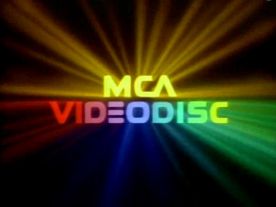 <iframe frameborder="0" height="209" src="http://wikifoundrytools.com/wiki/closinglogos/widget/genericvideo/0c90eb0dd39047c8e32f9ec0baaa76516f173e35" width="382"></iframe>
<iframe frameborder="0" height="209" src="http://wikifoundrytools.com/wiki/closinglogos/widget/genericvideo/0c90eb0dd39047c8e32f9ec0baaa76516f173e35" width="382"></iframe>
Nickname: "Flashing MCA Rainbow"
Logo: On a black screen, the words "A PRESENTATION OF" zoom-out in the 1972 MCA font in yellow before dissolving in the center. Following that are streaks of rainbow color that zoom out to the middle of the screen and flash to form...
...all in the MCA logo font. More rainbow streaks of light shoot out of the words and then settle back in.
FX/SFX: '80s computer effects.
Music/Sounds: A synth drone that culminates in a dreamy siren-like sound, ending with some synth bass notes.
Availability: Extremely rare. It's seen on all MCA Videodisc releases, both Laserdisc and CED, from 1981 to 1983. Some MCA Home Video releases from early 1983 on Laserdisc and CED, such as Psycho II, may have this instead of the MCA Home Video logo at the start. This appears on a pre-production United States VHD of Smokey and the Bandit, but VHD never made it to commercial release in the US.
MCA Videodisc
(1981-1983)
 <iframe frameborder="0" height="209" src="http://wikifoundrytools.com/wiki/closinglogos/widget/genericvideo/0c90eb0dd39047c8e32f9ec0baaa76516f173e35" width="382"></iframe>
<iframe frameborder="0" height="209" src="http://wikifoundrytools.com/wiki/closinglogos/widget/genericvideo/0c90eb0dd39047c8e32f9ec0baaa76516f173e35" width="382"></iframe>Nickname: "Flashing MCA Rainbow"
Logo: On a black screen, the words "A PRESENTATION OF" zoom-out in the 1972 MCA font in yellow before dissolving in the center. Following that are streaks of rainbow color that zoom out to the middle of the screen and flash to form...
MCA
VIDEODISC
VIDEODISC
...all in the MCA logo font. More rainbow streaks of light shoot out of the words and then settle back in.
FX/SFX: '80s computer effects.
Music/Sounds: A synth drone that culminates in a dreamy siren-like sound, ending with some synth bass notes.
Availability: Extremely rare. It's seen on all MCA Videodisc releases, both Laserdisc and CED, from 1981 to 1983. Some MCA Home Video releases from early 1983 on Laserdisc and CED, such as Psycho II, may have this instead of the MCA Home Video logo at the start. This appears on a pre-production United States VHD of Smokey and the Bandit, but VHD never made it to commercial release in the US.
Editor's Note: None.
---------------------------------------------------------------------------------------------------------
MCA Videocassette Inc.
(June 16, 1980-October 1983)
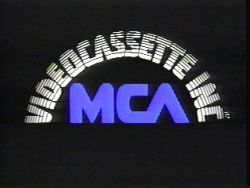
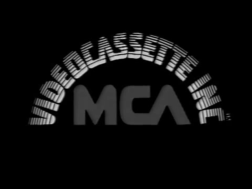
Nickname: "The Arc", "Videocassette Inc. MCA"
Logo: On a black background, the MCA logo appears in the center of the screen colored in blue. The words "VIDEOCASSETTE INC", in a white segmented font appear in an arc formation, surrounding the MCA logo through an "iris in" effect.
Variants:
FX/SFX: The rising in of "VIDEOCASSETTE INC."
Music/Sounds: None.
Availability: Extremely rare. Seen on every MCA Videocassette release from 1980 to 1983. However, your best bet is to find it on an early MCA Home Video reprint; details of some of these cases are below.
MCA Videocassette Inc.
(June 16, 1980-October 1983)


<iframe frameborder="0" height="184" src="http://wikifoundrytools.com/wiki/closinglogos/widget/genericvideo/fe419667ce451bf7f04cf9ee1dbdab55b9537777" width="243"></iframe>
Logo: On a black background, the MCA logo appears in the center of the screen colored in blue. The words "VIDEOCASSETTE INC", in a white segmented font appear in an arc formation, surrounding the MCA logo through an "iris in" effect.
Variants:
- Some black & white movies featured this logo in monochrome.
- Surprisingly, a still version of this logo was seen on the DVD release of Duck Soup at the end of the film's theatrical trailer.
- On The Seduction of Joe Tynan, instead of fading out, this logo cuts to the start of the feature.
FX/SFX: The rising in of "VIDEOCASSETTE INC."
Music/Sounds: None.
Availability: Extremely rare. Seen on every MCA Videocassette release from 1980 to 1983. However, your best bet is to find it on an early MCA Home Video reprint; details of some of these cases are below.
- A few of their first releases were Jaws, National Lampoon's Animal House, Psycho (which has the black & white variant), Smokey and the Bandit, and 1941.
- This was also used on some PolyGram Pictures movies distributed by Universal, such as An American Werewolf in London, Missing, King of the Mountain, The Pursuit of D.B. Cooper, and Endless Love.
- A few early MCA Home Video titles, like Monty Python's The Meaning of Life (which surprisingly retained this as late as 1993), Eddie Macon's Run, and Psycho II feature the latter logo on the packaging, but retain this logo both on-screen and on the tape labels.
- Other reprints have the exact opposite: the 1984 reprint of To Kill a Mockingbird (originally released 1981, in print into late 1985) reuses the 1981 box art and tape master, but has updated tape labels.
- Later reissues have both updated logos on the packaging and labels, but still preserve this logo on-screen due to reuse of older tape masters. This is the case with American Graffiti (1985 release, in print into early 1986) and The Bank Dick, starring W.C. Fields.
- Despite similar circumstances to the releases above, the 1984 reissue of 1941, which reuses the 1980 box art, has the logo below.
Editor's Note: This logo is very simple, especially when compared to the MCA Videodisc bumper of the time. However, this may be explained by MCA's heavy videodisc investment. Also, "VIDEOCASSETTE INC" really shouldn't be read before "MCA."
---------------------------------------------------------------------------------------------------------
MCA Home Video
1st Logo
(November 1983-May 10, 1990; June? 1991 (Canada))
Nicknames: "The Gold MCA", "The Zooming MCA", "MCA in Space", "Earth Yellow MCA", "VHS Assembly", "The MCA VHS Assembly"
Logo: On a CGI starry background, we see the MCA Home Video logo (in Earth yellow color). This logo has the usual MCA logo (with the "C" and "A" connected) and the words "HOME VIDEO" (in a sleek, smaller font that has the same width as "MCA") in a box that resembles a videotape (but "MCA" overlaps this box on the top, making it "cut open"). The logo zooms in slowly, like the Universal globe at the time. The logo fades out to the starry background for a second, and then an entire fade to black.
Variants:
FX/SFX: The stars and the zooming in of the logo.
Music/Sounds: None.
Availability: Uncommon. Check your thrift stores for tapes featuring this logo on the cover. It was seen on tapes such as the 1988 video release of E.T. the Extra-Terrestrial and the 1989 release of The Land Before Time (1991 and 1996 reprints use the first MCA/Universal logo). Others include the mid-late '80s releases of Back to the Future, An American Tail, *batteries not included, and Dragnet. The last releases to use this logo were Parenthood, Shocker, and Dad. It can also be found on Canadian Alliance Releasing Home Video VHS releases of Nightbreaker, Deadly Innocents, State of Mind (AKA: Private War), Teenage Mutant Ninja Turtles: The Movie, American Boyfriends, Iron Eagle II, Cameron's Closet, Nukie, A Whisper to a Scream, Final Cut (1989) (AKA: Lights! Cameras! Murder!), Bedroom Eyes II, Reason to Die, and Hot Times at Montclair High, among possible others. Some tapes up until 1991 with the MCA/Universal Home Video print logo on the cover may still have this due to being reprints of earlier MCA titles, such as Arabesque. It was also recently spotted on the 1991 Canadian Cineplex Odeon Video VHS release of The Grifters. However, this does not appear on the French Canadian International Video Entertainment release of Eddie et le Cruisers II: Eddie est de retour (Eddie and the Cruisers II: Eddie Lives).
Editor's Note: None.
2nd Logo
(1986-1990)
Nicknames: "Zooming/Sliding MCA", "VHS Assembly II", "The MCA VHS Assembly II"
Logo: The MCA Home Video logo appears in chrome (usually zooming in or sliding into the view). There are different variants:
FX/SFX: Typical late-'80s computer effects/animation.
Music/Sounds: The music or theme from whatever movie is being advertised.
Availability: Extremely rare. Seen primarily on trailers for MCA Home Video releases at the time.
Editor's Note: None.
MCA Home Video
1st Logo
(November 1983-May 10, 1990; June? 1991 (Canada))
<iframe frameborder="0" height="164" src="http://wikifoundrytools.com/wiki/closinglogos/widget/youtubevideo/bca546dbcbafbec01931a5477f9fe905d3ad1bd3" width="293"></iframe><iframe frameborder="0" height="164" src="http://wikifoundrytools.com/wiki/closinglogos/widget/youtubevideo/4781364a9b39a0b4fac310efb56e0fe18d277653" width="292"></iframe>
Logo: On a CGI starry background, we see the MCA Home Video logo (in Earth yellow color). This logo has the usual MCA logo (with the "C" and "A" connected) and the words "HOME VIDEO" (in a sleek, smaller font that has the same width as "MCA") in a box that resembles a videotape (but "MCA" overlaps this box on the top, making it "cut open"). The logo zooms in slowly, like the Universal globe at the time. The logo fades out to the starry background for a second, and then an entire fade to black.
Variants:
- Some later releases featured an announcement asking the viewer to stay tuned for previews of future releases that faded out shortly before the logo's appearance. Releases that use this variant include, but are not limited to, Brighton Beach Memoirs, Twins, Biloxi Blues, The Land Before Time, Field of Dreams, Shocker, Reason to Die (Canadian VHS), and The Dream Team.
- MCA releases co-released by GoodTimes Home Video have "UNDER LICENSE TO" at the bottom of the screen. The GoodTimes logo of the period would follow. A black & white version of this can be found on The Creature from the Black Lagoon. A similar variant was also spotted on the Kartes Video release of You Can't Cheat an Honest Man.
- On some French-Canadian tapes such as A Nightmare on Elm Street 5: The Dream Child, a French warning will appear before the logo.
- On the 1985 laserdisc of '60s Spartacus, the logo fades out earlier.
- On some early '80s VHS tapes featuring this logo, the logo fades in at the bottom, along with "Other Titles Available From" or "More Programming Available for You From" at the top, then the screen fades out afterwards. This can be seen on Merry Christmas, Mr. Lawrence, Max Maven's Mindgames, and The Lonely Guy and makes a surprise appearance on a 1996 reprint of the latter.
- Black and white movies would have this logo in black & white, such as The Wolf Man and Destry Rides Again.
- Some releases, such as the 1983 VHS of Jaws 3 and the 1980s VHS of Rear Window, often had this logo segueing into the 1963 Universal logo.
- Side opening bumpers on some MCA Home Video Laserdiscs between 1984 and 1986 used the stars by themselves, with "Side 2", "Side 3", etc., appearing by itself in the center of the screen, and then a fade out back to the stars. The 1984 Laserdisc release of Rear Window features this bumper.
FX/SFX: The stars and the zooming in of the logo.
Music/Sounds: None.
Availability: Uncommon. Check your thrift stores for tapes featuring this logo on the cover. It was seen on tapes such as the 1988 video release of E.T. the Extra-Terrestrial and the 1989 release of The Land Before Time (1991 and 1996 reprints use the first MCA/Universal logo). Others include the mid-late '80s releases of Back to the Future, An American Tail, *batteries not included, and Dragnet. The last releases to use this logo were Parenthood, Shocker, and Dad. It can also be found on Canadian Alliance Releasing Home Video VHS releases of Nightbreaker, Deadly Innocents, State of Mind (AKA: Private War), Teenage Mutant Ninja Turtles: The Movie, American Boyfriends, Iron Eagle II, Cameron's Closet, Nukie, A Whisper to a Scream, Final Cut (1989) (AKA: Lights! Cameras! Murder!), Bedroom Eyes II, Reason to Die, and Hot Times at Montclair High, among possible others. Some tapes up until 1991 with the MCA/Universal Home Video print logo on the cover may still have this due to being reprints of earlier MCA titles, such as Arabesque. It was also recently spotted on the 1991 Canadian Cineplex Odeon Video VHS release of The Grifters. However, this does not appear on the French Canadian International Video Entertainment release of Eddie et le Cruisers II: Eddie est de retour (Eddie and the Cruisers II: Eddie Lives).
Editor's Note: None.
2nd Logo
(1986-1990)
Logo: The MCA Home Video logo appears in chrome (usually zooming in or sliding into the view). There are different variants:
- On the VHS trailer for An American Tail (1986), the logo was in gold on a black background. The gold variant is nicknamed "The Gold MCA". The gold variant is also compared to the main logo.
- On the VHS trailer for Talk Radio (1988), the logo was in silver/chrome on an oatmeal gray background. It flashes red (to accompany the sound of the drumbeats used in the background music). This variant is nicknamed "The Silver MCA".
- On the VHS trailer for The Land Before Time (1988), the logo was in bright red and on a black background. This variant is nicknamed "The Red MCA".
- On the VHS trailer for Uncle Buck (1989), the "MCA HOME VIDEO" logo is in sky blue and slides in from the left on a black background. This variant is nicknamed "The Blue MCA". This also appears on the VHS trailer for Phantasm II (1988).
- On the VHS trailer for Shakedown (1988), the logo was in silver on a blue-black gradient background.
- On the VHS trailer for Hellgate (1989), seen at the end of a Canadian VHS of Reason to Die, we start with a shady gray background of diagonal bars with several "MCA HOME VIDEO" logos appearing inside the bars (like a wallpaper pattern). A sky blue "MCA HOME VIDEO" logo fades in the center and slowly zooms in while rotating/straitening itself into the view. This variant is nicknamed "The MCA Wallpaper". This also plasters the New World Pictures logo originally seen in this film's trailer.
FX/SFX: Typical late-'80s computer effects/animation.
Music/Sounds: The music or theme from whatever movie is being advertised.
Availability: Extremely rare. Seen primarily on trailers for MCA Home Video releases at the time.
Editor's Note: None.
---------------------------------------------------------------------------------------------------------
MCA/Universal Home Video
1st Logo
(May 22, 1990-1998)
Nicknames: "The Clean Globe", "Shiny Globe", "MCA Globe", "Shiny MCA Globe", "90s Globe", "90s MCA Globe"
Logo: On a black background, we see the following text all centered:
with "MCA" in its similar corporate font from before and has a white gradient texture on it and "UNIVERSAL" in its similar font as the movie logo from 1990-1997, but has a gradient texture on it. The text shines and soon afterwards, a globe (showing only the Americas) fades in the center. Then a starfield background fades in behind everything else, then the text shines again.
Variants:
FX/SFX: The slow appearances of the globe and the starfield background and the sparkling of the logo.
Music/Sounds: None. However, on The Making of E.T., the opening theme plays over the logo.
Availability: Common.
Editor's Note: The name on this logo became outdated in late 1996, as MCA ceased operations by that point, even more so when the movie division updated its logo several months later.
2nd Logo
(1990-1998)
Nicknames: "Airplane Passing Globe", "The Raining Filmstrips", "Rotating Globe", "90s Globe II", "MCA Globe II", "Morphing MCA Globe", "90s MCA Globe II", "From Classic to MCA Globe"
Logo: On a space background, we see the rotating globe in the 1930's style rotating. Coming from behind is an airplane passing over the globe, as usual, which flies through the screen, as the propeller becomes rainbow. Suddenly, rainbow filmstrips are seen falling over the logo before the nebula sky forming from filmstrips. Over the globe, while it changes into its 1990s style and in color, we see these words coming from the left and right sides of the screen (respectively) in their same corporate fonts:
A few seconds later, as "MCA" and "UNIVERSAL" go into their positions in front of the globe, a red orange/yellow gradient fire flies through the screen, forming the words "HOME VIDEO" underneath, with a line above it and the globe stops rotating afterwards. When the logo forms, either the "(R)" symbol or the "TM" symbol fades in on the bottom right of the screen.
Variants: There are three variations of this logo:
FX/SFX: The airplane passing globe, the transition from black and white to color, the letters rotating in, and the fire flying through the screen.
Music/Sounds: Usually the theme from whatever movie is being advertised, but the sound effects of the airplane are heard. Sometimes, it used a shortened version of the Universal theme (from that era). The trailer for the Back to the Future trilogy has the titular film's theme. On promotional VHS releases, a voiceover advertising upcoming releases is heard.
Availability: Uncommon. It was seen primarily on home video trailers and promotional VHS tapes at the time, as early as a demo tape for Bird on a Wire. The still version appeared on some trailers for The Adventures of Timmy the Tooth videos especially the promotional trailers for demo VHS tapes of the show and on the In-School Lesson video of it. Also seen on the trailer for The Shadow. The short version can be found on the 1995 release of The Little Rascals.
Editor's Note: Once again, the name became outdated by the end of 1996.
MCA/Universal Home Video
1st Logo
(May 22, 1990-1998)
<iframe frameborder="0" height="164" src="http://wikifoundrytools.com/wiki/closinglogos/widget/youtubevideo/153591e66bae9b81b2bc5a35a4b5d63fe7dfdf18" width="292"></iframe><iframe frameborder="0" height="163" src="http://wikifoundrytools.com/wiki/closinglogos/widget/youtubevideo/bb4584627eba12f256725fbf0b354e73a2905223" width="288"></iframe>
Logo: On a black background, we see the following text all centered:
MC/\
UNIVERSAL
H O M E------------- ------V I D E O
UNIVERSAL
H O M E------------- ------V I D E O
with "MCA" in its similar corporate font from before and has a white gradient texture on it and "UNIVERSAL" in its similar font as the movie logo from 1990-1997, but has a gradient texture on it. The text shines and soon afterwards, a globe (showing only the Americas) fades in the center. Then a starfield background fades in behind everything else, then the text shines again.
Variants:
- On some GoodTimes Home Video releases (i.e. Car Wash), the MCA/Universal logo plays normally. The background, however, has moving stars from the 1983 MCA Home Video logo in the background (as opposed to the regular version where the background stays static). At the end, the words "UNDER LICENSE TO" pops up, peeking above the globe as the logo fades out and the words straighten out at the center of the screen. The GoodTimes Home Video logo would follow.
- Some MCA/Universal releases have a GoodTimes byline at the bottom.
- On The Making of E.T., the logo is sped-up.
- A black-and-white version appears on some releases of black-and-white films (most notably To Kill a Mockingbird).
- A longer version appears on the original 1990 VHS of Back to the Future Part II.
FX/SFX: The slow appearances of the globe and the starfield background and the sparkling of the logo.
Music/Sounds: None. However, on The Making of E.T., the opening theme plays over the logo.
Availability: Common.
- This can be seen on almost all of the releases from MCA/Universal during the era, like An American Tail: Fievel Goes West, Jurassic Park, the Back to the Future sequels, 1991 and 1996 reprints of The Land Before Time (and its sequels up to the fifth film), Exo-Squad, Earthworm Jim, Back to the Future: The Animated Series, The Adventures of Timmy the Tooth, We're Back! A Dinosaur's Story, and Happy Gilmore (also makes a surprise appearance on its 2001 Universal Comedy Greats reprint).
- This made its first appearance on Back to the Future Part II, and also appears on a reprint of the original release.
- The logo continued to be used well into 1998 on some VHS releases, despite the 1997 Universal print logo appearing on their packaging. Some of the last releases using this logo include Liar Liar, The Land Before Time V: The Mysterious Island, Hercules & Xena: The Animated Movie, The Chipmunk Adventure, The Spooktacular New Adventures of Casper: Spooky and Poil Meet the Monsters/Dead of the Class, A Christmas Peril/Three Ghosts and a Baby, Leave It to Beaver (1997) and the Extended Edition VHS of Steven Spielberg's 1941.
- This also makes a surprise appearance on the Canadian Cineplex Odeon VHS of Beyond the Law (1993) and the Canadian Alliance Releasing Home Video VHS releases of Lauderdale (1989), Hellgate, Made in L.A., Playroom (1990), Quest for Love (1988), and The Emissary, among possible others.
- The black and white variant can be found on the 1991 VHS of To Kill a Mockingbird. It also appears before the Paramount logo on Starz Encore Westerns' current prints of The Virginian (1929).
- This makes surprise appearances at the end of The Secrets of the Back to the Future Trilogy documentary on the 2002 DVD release of Back to the Future Part III (which was part of the Back to the Future: The Complete Trilogy DVD set from 2002) and the beginning of The Making of Jurassic Park documentary on the 2000 Collector's Edition DVD of Jurassic Park. Both of these were likely sourced from Laserdisc masters (especially since the latter actually has the Laserdisc warning screen intact).
- Surprisingly, on a later VHS reprint of Fletch, the MCA/Universal logo and even the Universal Pictures logo in the film was replaced with the 1997 logo.
Editor's Note: The name on this logo became outdated in late 1996, as MCA ceased operations by that point, even more so when the movie division updated its logo several months later.
2nd Logo
(1990-1998)
Nicknames: "Airplane Passing Globe", "The Raining Filmstrips", "Rotating Globe", "90s Globe II", "MCA Globe II", "Morphing MCA Globe", "90s MCA Globe II", "From Classic to MCA Globe"
Logo: On a space background, we see the rotating globe in the 1930's style rotating. Coming from behind is an airplane passing over the globe, as usual, which flies through the screen, as the propeller becomes rainbow. Suddenly, rainbow filmstrips are seen falling over the logo before the nebula sky forming from filmstrips. Over the globe, while it changes into its 1990s style and in color, we see these words coming from the left and right sides of the screen (respectively) in their same corporate fonts:
MC/\
UNIVERSAL
UNIVERSAL
A few seconds later, as "MCA" and "UNIVERSAL" go into their positions in front of the globe, a red orange/yellow gradient fire flies through the screen, forming the words "HOME VIDEO" underneath, with a line above it and the globe stops rotating afterwards. When the logo forms, either the "(R)" symbol or the "TM" symbol fades in on the bottom right of the screen.
Variants: There are three variations of this logo:
- There is a version where the both the line and "HOME VIDEO" fade in as the comet flies through. That was seen on a demo tape for Bird on a Wire.
- There is a short version in which the airplane and filmstrips parts of the logo are cut out and begins with the words zooming and rotating in.
- There is a still version of the logo without music.
FX/SFX: The airplane passing globe, the transition from black and white to color, the letters rotating in, and the fire flying through the screen.
Music/Sounds: Usually the theme from whatever movie is being advertised, but the sound effects of the airplane are heard. Sometimes, it used a shortened version of the Universal theme (from that era). The trailer for the Back to the Future trilogy has the titular film's theme. On promotional VHS releases, a voiceover advertising upcoming releases is heard.
Availability: Uncommon. It was seen primarily on home video trailers and promotional VHS tapes at the time, as early as a demo tape for Bird on a Wire. The still version appeared on some trailers for The Adventures of Timmy the Tooth videos especially the promotional trailers for demo VHS tapes of the show and on the In-School Lesson video of it. Also seen on the trailer for The Shadow. The short version can be found on the 1995 release of The Little Rascals.
Editor's Note: Once again, the name became outdated by the end of 1996.
---------------------------------------------------------------------------------------------------------
Universal Pictures Home Entertainment
1st logo
(1997-1998)
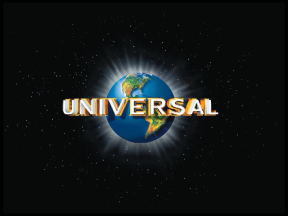
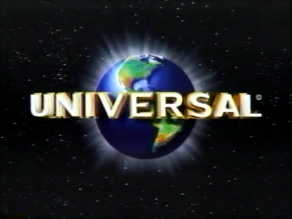
Nickname: "CGI Globe", "Still CGI Globe", "Boring CGI Globe"
2nd Logo
(1998-2012)
Nickname: "CGI Globe II", "Animated CGI Globe"
Logo: Only the 1997 Universal Pictures logo with no video indicator whatsoever. What's different about this version from the theatrical version is that this logo zooms back a little.
Trivia: The logo was originally going to be used on the 2006 DVD of Curious George (film), but it is not used for some reason. However, it can still be accessed by going to "Title 33" on the disc.
Editor's Note: This logo began a long-running trend of Universal using their movie logo as their home entertainment logo.
3rd Logo
(2012- )
Nicknames: "CGI Globe II", "Comcast Globe"
Logo: Same as the 2012 Universal Pictures logo, without video indicator whatsoever. Basically, it's another de-facto home video logo.
Variant: As with the theatrical counterpart, the words "100TH ANNIVERSARY" are shown below the "UNIVERSAL" text during this logo's first year of use (2012) to commemorate the studio's centennial.
FX/SFX: Same as the 2012 Universal Pictures logo.
Music/Sounds: Same as the 2012 Universal Pictures logo.
Availability: Common. First appeared on Universal and Focus Features releases such as Dr. Seuss' The Lorax, Safe House, American Reunion, ParaNorman, and the 2014 Blu-Ray release of Mallrats, among others. It can also be seen on American Thomas and Friends DVDs starting in late 2014.
Editor's Note: None.
FX/SFX: The CGI-animation of the filmstrip and the appearing of the text and globe.
Music/Sounds: A male announcer (Jerry Houser) says "Universal special editions, add them all to your video collection."
Availability: Can be seen on special edition releases from Universal Studios Home Video, such as The Sting, American Graffiti, National Lampoon's Animal House, Field of Dreams, and The Blues Brothers.
Editor's Note: None.
Universal Pictures Home Entertainment
1st logo
(1997-1998)


Nickname: "CGI Globe", "Still CGI Globe", "Boring CGI Globe"
Logo: Just a still picture of the 1997 Universal Pictures logo without the copyright info.
Trivia: This was used on the start up page of the Universal Studios website in 1997 which can be viewed <a href="https://web.archive.org/web/19970605010233/http://www.mca.com/" target="_self">here</a>.
Variant: A darker zoomed in version can be found on a home video trailer for the Hercules & Xena Video Collection on the 1998 VHS of Hercules & Xena: The Animated Movie.
FX/SFX: None.
Availability: Rare. This can be found on early DVDs released between 1997 and 1998 such as Kindergarten Cop, Beethoven, Backdraft, Waterworld, Happy Gilmore, The Shadow, Twins, Parenthood, Timecop and The Nutty Professor. This can be also be found on the original DVD releases of Liar Liar and National Lampoon's Animal House. The latter two were later re-released the same year on DVD as part of Universal's Collector's Edition series and would use the next logo.
Editor's Note: This is obviously a placeholder logo (a la the 1st, 2nd, and 7th logos of Columbia TriStar Home Video). Eventually, this was replaced by the movie logo, as seen below.
Trivia: This was used on the start up page of the Universal Studios website in 1997 which can be viewed <a href="https://web.archive.org/web/19970605010233/http://www.mca.com/" target="_self">here</a>.
Variant: A darker zoomed in version can be found on a home video trailer for the Hercules & Xena Video Collection on the 1998 VHS of Hercules & Xena: The Animated Movie.
FX/SFX: None.
Availability: Rare. This can be found on early DVDs released between 1997 and 1998 such as Kindergarten Cop, Beethoven, Backdraft, Waterworld, Happy Gilmore, The Shadow, Twins, Parenthood, Timecop and The Nutty Professor. This can be also be found on the original DVD releases of Liar Liar and National Lampoon's Animal House. The latter two were later re-released the same year on DVD as part of Universal's Collector's Edition series and would use the next logo.
Editor's Note: This is obviously a placeholder logo (a la the 1st, 2nd, and 7th logos of Columbia TriStar Home Video). Eventually, this was replaced by the movie logo, as seen below.
2nd Logo
(1998-2012)
Nickname: "CGI Globe II", "Animated CGI Globe"
Logo: Only the 1997 Universal Pictures logo with no video indicator whatsoever. What's different about this version from the theatrical version is that this logo zooms back a little.
Trivia: The logo was originally going to be used on the 2006 DVD of Curious George (film), but it is not used for some reason. However, it can still be accessed by going to "Title 33" on the disc.
Variants:
- On UK VHS and DVDs (mainly from Right Entertainment (Universal distributed tapes from this company), the logo has the Universal City Studios byline as well as the URL.
- An anamorphically enhanced widescreen version was created and used on all widescreen DVDs and some full screen DVDs of all pre-1997 Universal films. Strangely this isn't used on the 2002 2 Disc Limited Collector's Edition DVD of E.T. The Extra Terrestrial or the 2000 Collector's Edition DVD of Jurassic Park. Likely due to those using their own variants of the 1997 Universal logo before the main menus which can be viewed here. However, the 2003 "Double Secret Probation Edition" DVD of National Lampoon's Animal House still uses this while using it's own variant before the main menu.
- Two non anamorphic widescreen versions exist. The first one is presented in the 1.77 aspect ratio. The other one is presented in 1.85 aspect ratio. The 1.77 version can be found on Universal DVDs distributed by Image Entertainment such as Firestarter, Sixteen Candles, Midnight Run, Mystery Science Theater 3000: The Movie and Weird Science. The 1.85 version can be found on the DVDs of The Breakfast Club, The Wiz, Uncle Buck, The Great Outdoors and the Collector's Editions of The Blues Brothers, 1941 and John Carpenter's The Thing. A cut short version of the 1.85 variant can be found at the beginning of The Making Of Jaws documentary on the 2000 Anniversary Collector's Edition DVD of Jaws. Surprisingly, this is used at the beginning of the documentary: Beware the Moon: Remembering An American Werewolf in London, which can be found on the 2009 Full Moon Edition DVD/Blu-ray of An American Werewolf in London.
- A cut short version can be found at the end of most "making of" documentaries for VHS and DVD. It was also used at the beginning of VHS releases of Universal movies distributed by GoodTimes Home Video such as the 1998 VHS release of Jaws: The Revenge.
- There is a variant of the short version where the URL "www.universalstudios.com/home" appears at the bottom. This appears at the end of the "making of" featurette on the 1998 DVD of The Blues Brothers.
FX/SFX: Same as the Universal logo from 1997.
Music/Sounds: Same as the Universal logo from 1997 or the opening of the movie.
Music/Sound Variants:
Availability: Common. This was used as the de-facto home video logo.Appears on Focus Features releases, direct-to-DVDs, DVD versions of older, pre-1997 Universal movies, and made-for-TV family movies such as Balto III: Wings of Change, Pokémon: Giratina and the Sky Warrior, Alvin and the Chipmunks Meet Frankenstein, Alvin and the Chipmunks Meet the Wolfman, The Land Before Time sequels starting with The Land Before Time V: The Mysterious Island and ending with The Land Before Time XIII: The Wisdom of Friends, An American Tail sequels starting with An American Tail: The Treasure of Manhattan Island and ending with An American Tail: The Mystery of the Night Monster, LEGO: The Adventures of Clutch Powers, the 1971-1982 Dr. Seuss/DFE animated specials, and the Barbie direct-to-video films starting with Barbie of Swan Lake and ending with Barbie in A Mermaid Tale 2, among others. This logo with the NBC Universal byline was seen on An American Girl: McKenna Shoots for the Stars. It also made a surprise appearance on the Australian DVD release of U2: The Best of 1990-2000. This had also made a surprise appearance on Pontoffel Rock, Where Are You? (Pontoffel Rock & His Magic Piano on later video releases) on the 2012 Deluxe Edition DVD of The Lorax (1972) due to using the 2003 master as they forgot to cut the logo.
Music/Sounds: Same as the Universal logo from 1997 or the opening of the movie.
Music/Sound Variants:
- There is a higher tuned version which can be found at the beginning of Making An American Werewolf in London, which can be found on the 2001 Collector's Edition DVD of An American Werewolf in London.
- A silent version can be found at the end of The Stories Behind The Making of The Blues Brothers, which can be found on the 1998 Collector's Edition DVD of The Blues Brothers.
Availability: Common. This was used as the de-facto home video logo.Appears on Focus Features releases, direct-to-DVDs, DVD versions of older, pre-1997 Universal movies, and made-for-TV family movies such as Balto III: Wings of Change, Pokémon: Giratina and the Sky Warrior, Alvin and the Chipmunks Meet Frankenstein, Alvin and the Chipmunks Meet the Wolfman, The Land Before Time sequels starting with The Land Before Time V: The Mysterious Island and ending with The Land Before Time XIII: The Wisdom of Friends, An American Tail sequels starting with An American Tail: The Treasure of Manhattan Island and ending with An American Tail: The Mystery of the Night Monster, LEGO: The Adventures of Clutch Powers, the 1971-1982 Dr. Seuss/DFE animated specials, and the Barbie direct-to-video films starting with Barbie of Swan Lake and ending with Barbie in A Mermaid Tale 2, among others. This logo with the NBC Universal byline was seen on An American Girl: McKenna Shoots for the Stars. It also made a surprise appearance on the Australian DVD release of U2: The Best of 1990-2000. This had also made a surprise appearance on Pontoffel Rock, Where Are You? (Pontoffel Rock & His Magic Piano on later video releases) on the 2012 Deluxe Edition DVD of The Lorax (1972) due to using the 2003 master as they forgot to cut the logo.
Editor's Note: This logo began a long-running trend of Universal using their movie logo as their home entertainment logo.
3rd Logo
(2012- )
<iframe frameborder="0" height="182" src="http://wikifoundrytools.com/wiki/closinglogos/widget/genericvideo/ae873160393ed920d5bd1f0ab5077b252c44d805" width="319"></iframe>
Nicknames: "CGI Globe II", "Comcast Globe"
Logo: Same as the 2012 Universal Pictures logo, without video indicator whatsoever. Basically, it's another de-facto home video logo.
Variant: As with the theatrical counterpart, the words "100TH ANNIVERSARY" are shown below the "UNIVERSAL" text during this logo's first year of use (2012) to commemorate the studio's centennial.
FX/SFX: Same as the 2012 Universal Pictures logo.
Music/Sounds: Same as the 2012 Universal Pictures logo.
Availability: Common. First appeared on Universal and Focus Features releases such as Dr. Seuss' The Lorax, Safe House, American Reunion, ParaNorman, and the 2014 Blu-Ray release of Mallrats, among others. It can also be seen on American Thomas and Friends DVDs starting in late 2014.
Editor's Note: None.
---------------------------------------------------------------------------------------------------------
Universal Studios DVD
(April 28, 1998-2001)
Nicknames: "CGI DVD Globe", "DVD Globe"
Logo: A series of clips from various Universal Studios-owned films plays, between clips the animation of the 1997 Universal Studios logo is seen. The logo then finishes as normal, only the globe rises up and the DVD logo fades in underneath.
Trivia: This logo was used as an advertisement for Universal Studios Home Video DVD releases. However, in this version the titles of various films are shown to promote their releases.
FX/SFX: The flashes between the film clips and the Universal Studios logo and the fading in of the DVD logo.
Music/Sounds: A sample from "Ecosystem" by John Pratt and Michael Alemania.
Availability: Can be seen on DVD releases by Universal Studios Home Video from April 28, 1998 to 2001. Some examples include The Little Rascals, Major Payne, Babe: Pig In The City, and the Collector's Edition DVDs of the Jurassic Park trilogy, National Lampoon's Animal House (Collector's Edition), 1941, Street Fighter (Collector's Edition)and other 1998-2001 DVD releases. Strangely, this doesn't appear on the 2000 Anniversary Collector's Edition DVD of Jaws, the 1998 Collector's Edition DVD of The Blues Brothers or the 2001 Collector's Edition DVD of How The Grinch Stole Christmas (the 2000 Jim Carrey movie).
Editor's Note: None.
Universal Studios DVD
(April 28, 1998-2001)
Logo: A series of clips from various Universal Studios-owned films plays, between clips the animation of the 1997 Universal Studios logo is seen. The logo then finishes as normal, only the globe rises up and the DVD logo fades in underneath.
Trivia: This logo was used as an advertisement for Universal Studios Home Video DVD releases. However, in this version the titles of various films are shown to promote their releases.
FX/SFX: The flashes between the film clips and the Universal Studios logo and the fading in of the DVD logo.
Music/Sounds: A sample from "Ecosystem" by John Pratt and Michael Alemania.
Availability: Can be seen on DVD releases by Universal Studios Home Video from April 28, 1998 to 2001. Some examples include The Little Rascals, Major Payne, Babe: Pig In The City, and the Collector's Edition DVDs of the Jurassic Park trilogy, National Lampoon's Animal House (Collector's Edition), 1941, Street Fighter (Collector's Edition)and other 1998-2001 DVD releases. Strangely, this doesn't appear on the 2000 Anniversary Collector's Edition DVD of Jaws, the 1998 Collector's Edition DVD of The Blues Brothers or the 2001 Collector's Edition DVD of How The Grinch Stole Christmas (the 2000 Jim Carrey movie).
Editor's Note: None.
---------------------------------------------------------------------------------------------------------
Universal Studios Home Video Special Editions
(1998-1999)
Nicknames: "Special Edition Globe", "Filmstrip Globe"
Logo: A scene from an upcoming release of a film is shown and zooms out onto CGI-animation of a filmstrip. Another film strip appears and the text"SPECIAL" (on the left) and "EDITIONS" (on the right) appear with silver bars appear on the top and bottom of the filmstrip and the letters are spaced out. The 1997 Universal Studios logo appears in the center. A copyright for Universal Studios Home Video, Inc. appears underneath.
FX/SFX: The CGI-animation of the filmstrip and the appearing of the text and globe.
Music/Sounds: A male announcer (Jerry Houser) says "Universal special editions, add them all to your video collection."
Availability: Can be seen on special edition releases from Universal Studios Home Video, such as The Sting, American Graffiti, National Lampoon's Animal House, Field of Dreams, and The Blues Brothers.
Editor's Note: None.
---------------------------------------------------------------------------------------------------------
Universal Studios Home Video Widescreen Edition
Universal Studios Home Video Widescreen Edition
(1998)
FX/SFX: The zooming out of the Universal Studios logo and the flowing background.
Music/Sounds: A male announcer says "The Universal Studios Home Video Widescreen Collection."
Availability: Can be seen on widescreen releases from Universal Studios Home Video, such as the 1998 Widescreen VHS release of The Sting.
Editor's Note: None.
Nicknames: "Widescreen Globe"
Logo: The 1997 Universal Studios logo appears and zooms out slightly onto a yellow background that has a flowing effect on it, similar to the 1995 Columbia TriStar Home Video logo. The words "WIDESCREEN EDITION" are underneath the Universal Studios logo and is in white.
FX/SFX: The zooming out of the Universal Studios logo and the flowing background.
Music/Sounds: A male announcer says "The Universal Studios Home Video Widescreen Collection."
Availability: Can be seen on widescreen releases from Universal Studios Home Video, such as the 1998 Widescreen VHS release of The Sting.
Editor's Note: None.
---------------------------------------------------------------------------------------------------------
Universal HD-DVD/Blu-ray Disc
(2006-2012)
Logo: Here are the variants used on HD-DVD and Blu-ray Disc:
Trivia: This logo was used on Universal HD-DVD releases from 2006-2008 and Blu-ray Disc releases since July 22, 2008 until early to mid-2012.
FX/SFX: Same as the 1997 logo, except the end on the HD-DVD version.
Music/Sounds: The 1997 Universal fanfare.
Availability: On every Universal HD-DVD and Blu-Ray Disc release from the era.
Editor's Note: None.
Universal HD-DVD/Blu-ray Disc
(2006-2012)
- HD-DVD: An updated edition of the 1997 logo. The logo plays normally but with updated animation and several dots coming out of the globe instead of streaks. At the end, the logo zooms back to reveal it is being reflected in a giant "HD-DVD" logo in the same space background. The logo shines.
- Blu-Ray Disc: Same as above, except the "HD-DVD" logo is omitted.
Trivia: This logo was used on Universal HD-DVD releases from 2006-2008 and Blu-ray Disc releases since July 22, 2008 until early to mid-2012.
FX/SFX: Same as the 1997 logo, except the end on the HD-DVD version.
Music/Sounds: The 1997 Universal fanfare.
Availability: On every Universal HD-DVD and Blu-Ray Disc release from the era.
Editor's Note: None.
